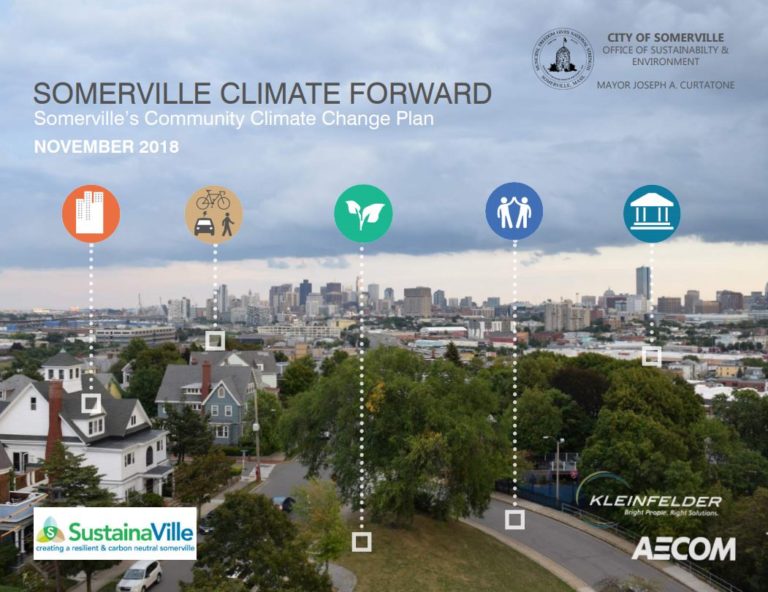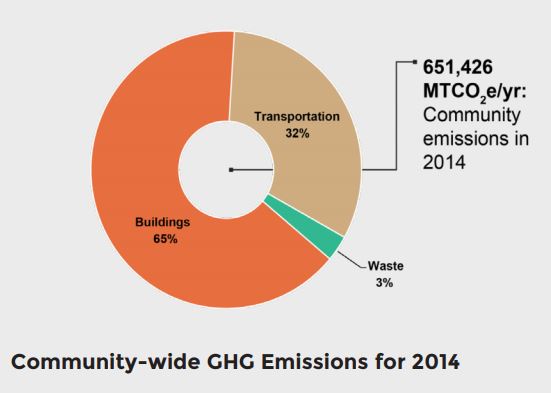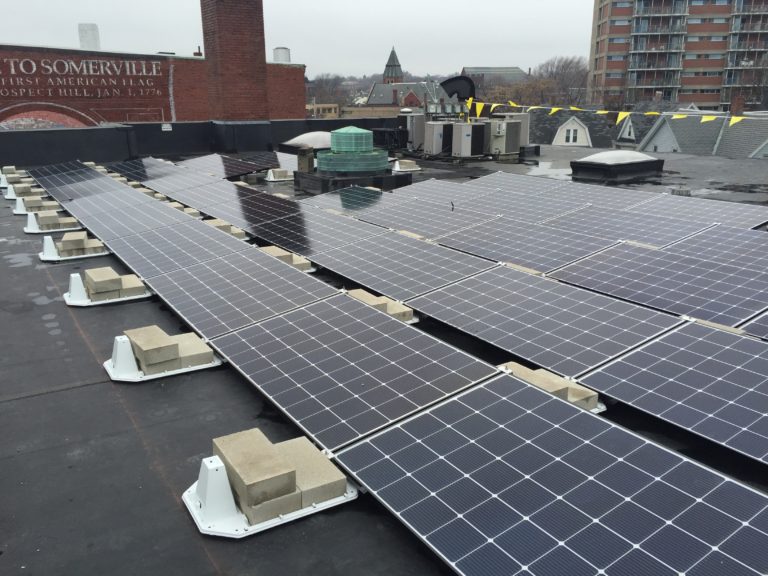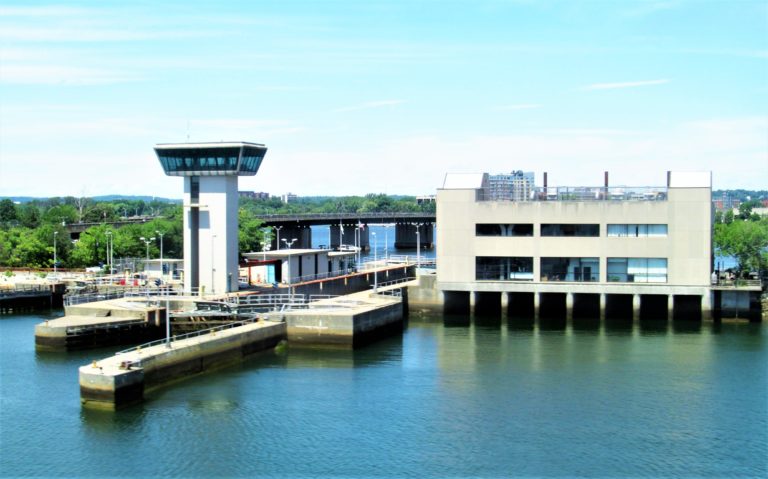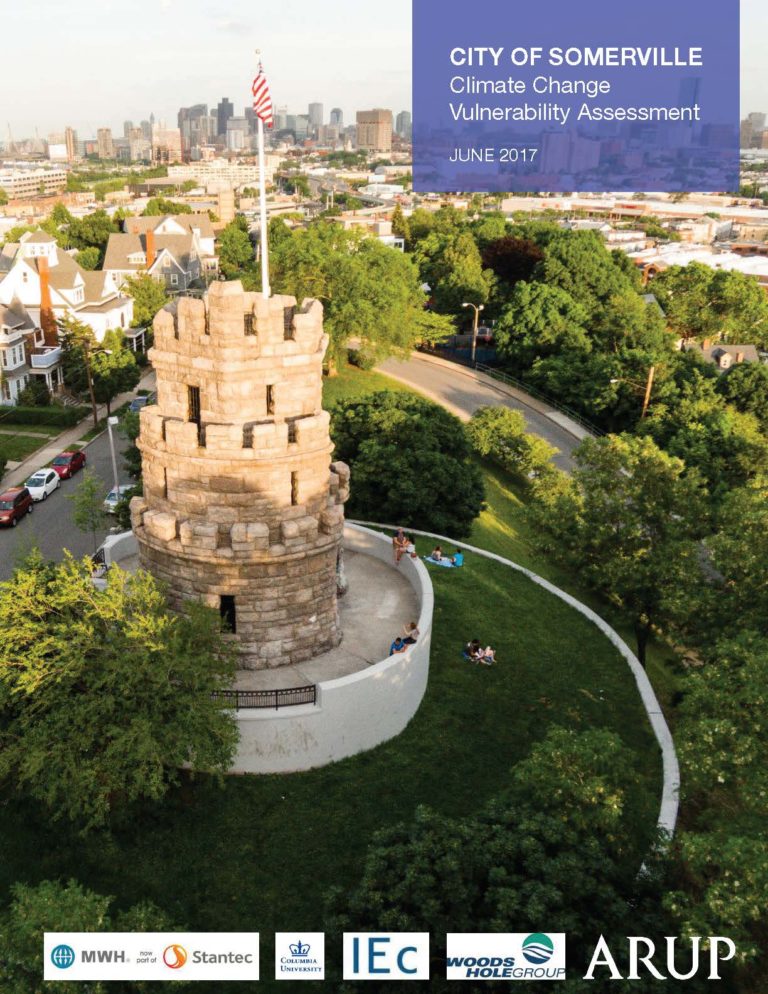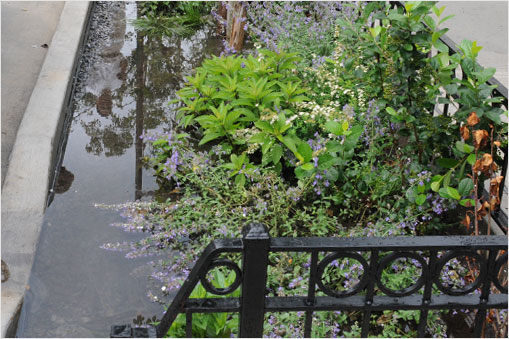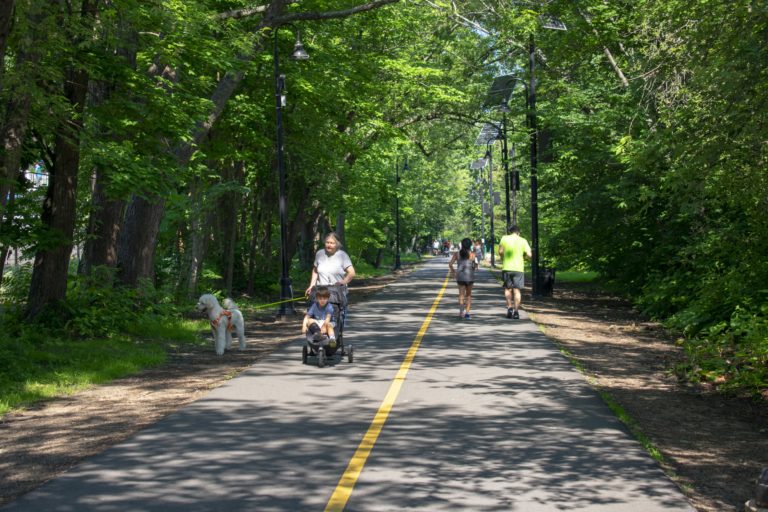SomerVision Number
from 2014 levels
The scope of the Climate and Sustainability topic chapter is: climate change mitigation, climate change adaptation, resiliency, energy efficiency, waste reduction, environmentalism, renewable energy, carbon neutrality, and pollution prevention and mitigation.
Somerville Climate Forward is Somerville’s first comprehensive climate change plan, grounded by a set of implementable actions. These tasks aim to reduce Somerville’s contribution to climate change and work towards carbon neutrality, to prepare Somerville for the unavoidable impacts of climate change, and to fairly distribute the opportunities created by climate action and work to alleviate the unequal burdens of climate change.
STRENGTHS
In considering climate and sustainability in Somerville, the working group wants to build on the solid foundation in SomerVision 2030 and Somerville Climate Forward, our climate action plan. SomerVision 2030 established sustainability as one of our community’s key values. The working group builds on this in SomerVision 2040 by making Climate and Sustainability a new topic chapter with a focus on:
Strong environmental leadership
Balanced transportation modes
Engaging recreational and community spaces
Improved community health and access to prevention and protective services
Effective stewardship of our natural resources
In addition, Climate Forward extensively considered the changes that will reduce emissions in the following sectors:
Buildings
Transportation
Environment (stormwater management, tree canopy expansion, consumption patterns)
Community (education, civic, and community participation)
Leadership to advocate for issues that can only be addressed at state or even federal levels
Many Somerville residents are already aware of climate change and other environmental issues and are eager to take action. This existing awareness will help to support individual efforts and mobilize needed behavior change at a larger scale.
Beyond policy positions, the City has implemented several programs and physical designs to to enable the community to make sustainable lifestyle choices. The City developed the Somerville Waste Wizard to answer resident questions about how to safely dispose of waste and electronics. Textile recycling was recently launched. The City has invested in cycling facilities, including a bikeshare program to make biking a more attractive option. Priority bus lanes on Broadway makes bus service more reliable and attractive for riders even during heavy traffic. Investments to increase the city’s tree canopy will help cool the city during the summer. Somerville is conducting parking reviews to evaluate the city’s relationship with cars, especially in corridors with robust public transit.
The Green Line Extension will soon offer further public transit opportunities. In 2016 the Solarize Somerville campaign led to the installation of over 100 solar arrays on Somerville homes. If you’re interested and haven’t yet been engaged, check out Sustainaville, the City’s home to the programs and initiatives to reduce our contribution to climate change and increase climate awareness.
Climate Forward is Somerville’s first comprehensive climate change plan, grounded by a set of implementable actions. These tasks aim to reduce Somerville’s contribution to climate change and work towards carbon neutrality, to prepare Somerville for the unavoidable impacts of climate change, and to fairly distribute the opportunities created by climate action and work to alleviate the unequal burdens of climate change.
Environmental justice seeks to ensure the equitable distribution of environmental risks and benefits and fair and meaningful participation in environmental decision-making for all people, regardless of race, color, national origin, or income. In Massachusetts, an Environmental Justice Community is an area with a median household income that is equal to or less than 65% of the statewide median, or an area with over 25% of residents identifying as a race other than white, or an area with over 25% of households having no one over the age of 14 who speaks English very well, or some combination of the three
CHALLENGES & OPPORTUNITIES
There are many challenges and opportunities related to climate change and sustainability because the problem is not simple to solve. Solutions are local and global and action needs to be taken in a wide variety of ways. We’ve identified the issues as: scale of influence, existing infrastructure, the environment and health equity, air quality, and engagement.
The biggest challenge facing Somerville are issues of scale. Much of what we know is environmentally harmful to Somerville is outside of municipal control. The air pollution from Interstate 93 is mostly from cars passing through and not beholden to any Somerville rules. Buildings in Somerville are the biggest consumers of fossil fuels, but Somerville has limited ability to impose new building codes because this is done at the State level. Similarly, transportation requirements like miles-per-gallon minimums are set by federal authorities. Many of the emissions contributing to climate change can only reform through policy change at different levels of government or from technological solutions.
Changes in Somerville will not be enough to stop climate change nor shelter Somerville residents from its impacts. Our actions may not produce any near-term, discernible benefits and makes it difficult to justify the costs of action on the municipal scale. This lack of control often manifests locally in resistance to changes that would make our community more sustainable. However, municipalities have an important role in effectively mitigating and preparing for climate change. It takes individual investment of cities to reduce their own GHG emissions and prepare for the impacts of climate change in order to move toward the collective impact necessitated by the current challenges
and opportunities.
Climate change is driven by fossil fuel emissions and efforts to reduce emissions will require addressing well-established infrastructure. Buildings contribute 65% of Somerville’s greenhouse gas emissions (GHG). Most are privately owned, so mitigating steps, if not mandated, will occur based on property owner interest and willingness to pay. Especially in circumstances where tenants are paying the energy bills, there is little incentive to improve. In addition, it will take drastic changes to wean the housing stock off fossil fuels.
Transportation contributes nearly all the remaining GHG from Somerville (32%) and is attributable almost entirely to single occupancy vehicles. Policy throughout the United States has privileged car ownership by directing tax money to build and maintain roads, zoning for an oversupply of parking, and creating below market-rate parking permit schemes. any residents purchased cars assuming these policies would continue, and fight for it to remain so.
However, this perpetuates the problem. In order to impact the number of cars owned by Somerville residents the City should consider limiting the number of subsidies available – market rate parking policies, zoning to not create an oversupply of parking, and right-sizing roads for all modes. While electrifying cars can reduce carbon emissions, reducing cars and vehicle miles traveled (VMTs) overall will be difficult to do while so many subsidies remain in place. The City is constantly balancing the needs of all roadway users whether motorists, cyclist, or pedestrian.
The remaining three percent of carbon emissions come from waste, particularly from plastic waste. Plastic waste, especially from packaging, is an integral part of the US economy and very difficult to avoid. But, because plastic waste emerges from a myriad of sources yet contributes to less than three percent of Somerville’s carbon emissions, even solving the problem would not provide a major contribution to making Somerville carbon neutral.
The effects of climate change will not be uniformly or equitably distributed. Those who are least likely to afford mitigation costs will also be the greatest impacted. Certain populations are more vulnerable to the impacts of climate change such as children, older adults, and people with disabilities. The Wellbeing of Somerville Report provides several examples of how age and socio-economic status may put certain groups within Somerville at an increased risk:
• Young children have a limited ability to communicate when overheating or when left in dangerous situations and are less self-sufficient, more reliant on adults for transportation and other needs, and less likely to cope emotionally during a disaster or climate event;
• New residents to Somerville may not be aware of emergency alerts and services available and may have difficulty with language access;
• Renters may have less capacity to make improvements to their homes and therefore could be more vulnerable to heat waves and flooding; and
• Older adults are more susceptible to extreme heat, the impacts from poor air quality, and insect-borne diseases and they may find it more difficult to access support services or evacuate during a climate event.
In addition, income and/or wealth influences the capacity to prepare for and recover from an extreme climate event. Thus, it is important to consider the role of policies, programs, and institutions which have historically distributed risks and opportunities unequally across the population.
According to the National Climate Assessment, climate change will affect human health by increasing ground-level ozone and/or particulate matter air pollution. The Wellbeing of Somerville Report highlights air quality as an environmental issue with serious health implications. Research shows that Somerville is a community disproportionately burdened with poor air quality, especially in the neighborhoods adjacent to Interstate 93 and Route 38. Recent studies have shown that ultrafine particles emitted from traffic are associated with (Walker, Douglas I., et al. “Metabolomic assessment of exposure to near-highway ultrafine particles.” Journal of exposure science & environmental epidemiology (2018): 1) respiratory infections, lung cancer, heart attacks, stroke and chronic obstructive pulmonary disease and are associated with elevated risk of asthma, heart conditions, and obesity.
Ensuring a just and equitable transition to a clean energy economy and a clean energy future will not be easy. However, it’s critical that any system the City deploys incorporates various language translations, easy access to information, and community events.
Climate change will affect everyone in some way or another. To move forward, we must focus on the opportunities that are available to us.Climate and Sustainability overlaps with several other chapters. Sustainability will need to be incorporated into all future plans that have any impact or expectation for future fossil emissions.
Focus on our largest GHG contributor. Buildings are the largest contributor to Somerville’s emissions, and we need to continue to focus on them even though we have limited leverage. We need to support building retrofits, keeping in mind that improvements resulting in rent increases is an undesirable outcome.
GOALS AND TAKEAWAYS
Leverage control. Above all, Somerville needs to understand what aspects of emissions we have control over, and what we can do within that realm to reset unconscious norms. For example, supporting permeable pavement or planting native plants or trees able to survive the anticipated heat. These must be deliberately considered and acted upon.
Target behavior change. Behavior change is needed to reduce greenhouse gas emissions. The community wants to make better choices, but the City should support efforts to make “better choices” more intuitive and straightforward.
Re-evaluate programs. Programs that were the right fit for the Somerville of 10, 20, 50 years ago, might not be the right fit for the Somerville of today. For example, the City currently utilizes zero-sort recycling (a SomerVision 2030 recommendation), which often has the unfortunate side-effect of decreasing the efficacy of recycling programs. We should continually monitor the results of programs to make sure they’re still the best fit for our community and stated goals.
Expand messaging. Climate change solutions will entail large changes for residents, local businesses, and how the City operates. How can we help the community understand and accept these changes prior to implementation?
Continue to educate and incentivize. Somerville can think creatively about how to incentivize positive behavior change (for example commuting by bike instead of by car or having a public forum to formalize commitments to fly less like Europe’s No-Fly Pledges.
Integrate sustainability in other City objectives. Whether the city budget, neighborhood planning, or regulation, we need to integrate sustainability in all City processes, especially the way we live and move about.
Include food. Food systems are both heavily impacted and contributors to climate change and a community’s resilience. In line with the Somerville Food Assessment findings, Somerville should aim to minimize the amount of food that is wasted and support local emergency food providers in creating a more cohesive network for receiving and distributing recoverable food.
Prioritize Infrastructure. Our infrastructure plays a critical role in improving our sustainability and resiliency to future climate events. We should explore traditional and innovative ways of addressing our problems.
Focus on our largest GHG contributor. Buildings are the largest contributor to Somerville’s emissions, and we need to continue to focus on them even though we have limited leverage. We need to support building retrofits, keeping in mind that improvements resulting in rent increases is an undesirable outcome.
A vulnerability assessment explores what aspects of a system might be sensitive to certain threats. The City’s Climate Change Vulnerability Assessment focused particularly on sea level rise and storm surge, precipitation, and temperature to analyze how the city would be directly affected by anticipated climate change. This enabled the City to identify the most at-risk populations, assets, and systems, which informed the Climate Forward planning process.



